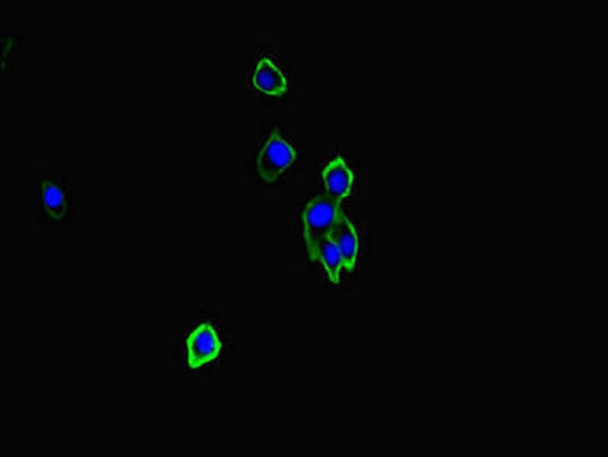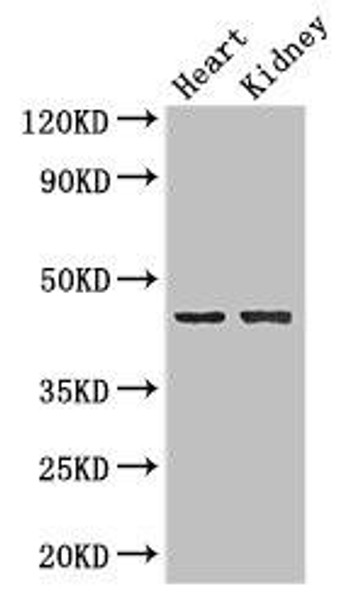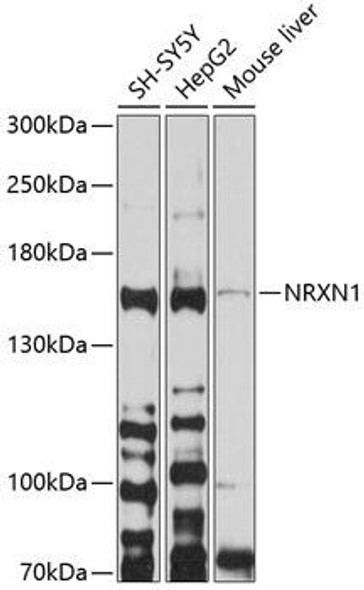Description
NRXN1 Antibody (PACO46446)
The NRXN1 Polyclonal Antibody (PAC04646) is a valuable tool for researchers studying NRXN1, a cell adhesion molecule known for its role in synaptic function and neurological disorders. This antibody, produced in rabbits, is highly specific for human samples and has been validated for use in Western blot applications. By targeting the NRXN1 protein, this antibody allows for the detection and analysis of NRXN1 in various cell types, making it an excellent choice for studies in neuroscience and neurobiology.NRXN1 is a key player in synaptic signaling and has been implicated in disorders such as autism spectrum disorders and schizophrenia.
Its involvement in synaptic transmission and plasticity makes it a compelling target for research aimed at understanding the molecular mechanisms underlying neurological conditions. By studying NRXN1 expression and function, researchers can gain valuable insights into the pathophysiology of these disorders and potentially identify therapeutic targets for intervention.Overall, the NRXN1 Polyclonal Antibody (PAC04646) offers high sensitivity and specificity for detecting NRXN1 in human samples, making it an essential tool for researchers investigating the role of NRXN1 in synaptic function and neurological disorders.
| Antibody Name: | NRXN1 Antibody (PACO46446) |
| Antibody SKU: | PACO46446 |
| Size: | 50ug |
| Host Species: | Rabbit |
| Tested Applications: | ELISA, WB, IF |
| Recommended Dilutions: | ELISA:1:2000-1:10000, WB:1:2000-1:5000, IF:1:50-1:200 |
| Species Reactivity: | Human, Mouse |
| Immunogen: | Recombinant Human Neurexin-1-β protein (184-363AA) |
| Form: | Liquid |
| Storage Buffer: | Preservative: 0.03% Proclin 300 Constituents: 50% Glycerol, 0.01M PBS, PH 7.4 |
| Purification Method: | >95%, Protein G purified |
| Clonality: | Polyclonal |
| Isotype: | IgG |
| Conjugate: | Non-conjugated |
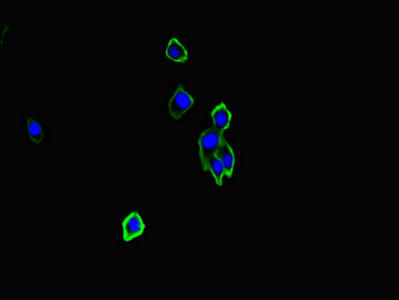 | Immunofluorescent analysis of HepG2 cells using PACO46446 at dilution of 1:100 and Alexa Fluor 488-congugated AffiniPure Goat Anti-Rabbit IgG(H+L). |
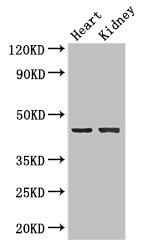 | Western Blot. Positive WB detected in: Mouse heart tissue, Mouse kidney tissue. All lanes: NRXN1 antibody at 2µg/ml. Secondary. Goat polyclonal to rabbit IgG at 1/50000 dilution. Predicted band size: 47, 51, 162, 165, 170, 16 kDa. Observed band size: 47 kDa. |
| Background: | Neuronal cell surface protein that may be involved in cell recognition and cell adhesion by forming intracellular junctions through binding to neuroligins. May play a role in formation or maintenance of synaptic junctions. May mediate intracellular signaling. May play a role in angiogenesis (By similarity). |
| Synonyms: | Neurexin-1-β (Neurexin I-beta), NRXN1 |
| UniProt Protein Function: | NRXN1 iso5: Cell surface protein involved in cell-cell-interactions, excytosis of secretory granules and regulation of signal transmission. Function is isoform-specific. Alpha-type isoforms have a long N-terminus with six laminin G-like domains and play an important role in synaptic signal transmission. Alpha-type isoforms play a role in the regulation of calcium channel activity and Ca(2+)-triggered neurotransmitter release at synapses and at neuromuscular junctions. They play an important role in Ca(2+)- triggered exocytosis of secretory granules in pituitary gland. They may effect their functions at synapses and in endocrine cells via their interactions with proteins from the exocytotic machinery. Likewise, alpha-type isoforms play a role in regulating the activity of postsynaptic NMDA receptors, a subtype of glutamate-gated ion channels. Both alpha-type and beta-type isoforms may play a role in the formation or maintenance of synaptic junctions via their calcium-dependent interactions (via the extracellular domains) with neuroligin family members, CBLN1 or CBLN2. In vitro, triggers the de novo formation of presynaptic structures. May be involved in specification of excitatory synapses. Alpha-type isoforms were first identified as receptors for alpha-latroxin from spider venom. Belongs to the neurexin family. 4 isoforms of the human protein are produced by alternative promoter. |
| UniProt Protein Details: | Protein type:Membrane protein, integral; Receptor, misc. Chromosomal Location of Human Ortholog: 2p16.3 Cellular Component: cell soma; cell surface; endoplasmic reticulum; integral to plasma membrane; nuclear membrane; plasma membrane; presynaptic membrane; vesicle Molecular Function:acetylcholine receptor binding; calcium channel regulator activity; calcium ion binding; cell adhesion molecule binding; protein binding; receptor activity Biological Process: adult behavior; axon guidance; learning; neuromuscular process controlling balance; neuron adhesion; neurotransmitter secretion; positive regulation of synaptic transmission, glutamatergic; positive regulation of synaptogenesis; social behavior; synaptic transmission; synaptogenesis; vocal learning Disease: Autism |
| NCBI Summary: | This gene encodes a single-pass type I membrane protein that belongs to the neurexin family. Neurexins are cell-surface receptors that bind neuroligins to form Ca(2+)-dependent neurexin/neuroligin complexes at synapses in the central nervous system. This complex is required for efficient neurotransmission, and is involved in the formation of synaptic contacts. Three members of this gene family have been studied in detail and are estimated to generate over 3,000 variants through the use of two alternative promoters (alpha and beta) and extensive alternative splicing in each family member. Recently, a third promoter (gamma) was identified for this gene in the 3' region. The RefSeq project has decided to create only a few representative transcript variants of the multitude that are possible. Mutations in this gene are associated with Pitt-Hopkins-like syndrome-2. [provided by RefSeq, Feb 2016] |
| UniProt Code: | P58400 |
| NCBI GenInfo Identifier: | 322510054 |
| NCBI Gene ID: | 9378 |
| NCBI Accession: | P58400.2 |
| UniProt Related Accession: | Q9ULB1,P58400 |
| Molecular Weight: | 161,883 Da |
| NCBI Full Name: | Neurexin-1-beta |
| NCBI Synonym Full Names: | neurexin 1 |
| NCBI Official Symbol: | NRXN1 |
| NCBI Official Synonym Symbols: | PTHSL2; SCZD17; Hs.22998 |
| NCBI Protein Information: | neurexin-1 |
| UniProt Protein Name: | Neurexin-1-beta |
| UniProt Synonym Protein Names: | Neurexin I-beta |
| Protein Family: | Neurexin |
| UniProt Gene Name: | NRXN1 |
| UniProt Entry Name: | NRX1B_HUMAN |

